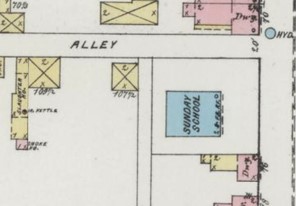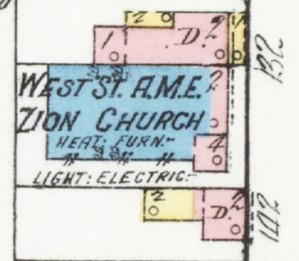Runaway Servants
Servants played an important role in the economy of colonial and post-Revolutionary War America.
Top: Associate Presbyterian Church, South West Street, Carlisle. Photo by A. A. Line – (32-01-02).
Middle: The windows on the north side of the church, as seen from Chapel Alley. – (32-01-01).
Bottom: West Street A.M.E. Zion Church, 1927 - (32-34-02).
The two oldest church buildings still standing in their original locations in Carlisle are the First Presbyterian Church on the Square and the Associate Presbyterian “Seceder” Church on South West Street, currently the West Street A.M.E. Zion Church.
“The Associate Presbyterian congregation of Carlisle was organized in 1798. The lot on West Street, upon which the church was built, was conveyed, in consideration of £6, by the Messrs. Penn, in 1796 to William Blair, William Moore, John Smith and John McCoy, trustees of the Associate Presbyterian congregation…The building was put up in 1802, and the Rev. Francis Pringle, their first pastor, was called the same year.”1
Sixty-one years after the church was erected, it was sold to Dr. George Ross of Lebanon for use of the Eastern eldership of the Church of God. “It is a fine large stone building forty by sixty with a lot of eighty feet front,” the newspaper reported. “They will get possession on the first of November when they will begin remodeling and fitting up for worship.”2
By April 1864, the newspaper reported that “The remodeling of the Seceder Church, purchased lately for the use of the Church of God, is being rapidly pushed to completion. The carpenters have finished their work, and it now awaits the plasterer and painter. Additional doors and windows, the latter of red stippled glass, have greatly improved the outside appearance, while the inside arrangement is neat, commodious and comfortable, and is very creditable to those who have the work in charge. It will, we learn, be dedicated sometime next month.”3
Eighteen years after the Church of God purchased the building, it was advertised to be sold at a public sale on December 15, 1881.4 Thomas Groome, of Carlisle, bought the church at a private sale in January 1882 for $1,100.5 Interestingly, the newspaper reported that in September 1882, the African Methodist congregation of North Street purchased the building on West Street from the Church of God for $1,200.6
In July 1910, the members of the West Street A.M.E. Zion church decided to remodel the old stone structure and awarded the contract to James Porter. The newspaper reported that the “front addition will extend fourteen feet and will be of pressed brick. The second story will be in conformity to the present room as to width, etc., but the seating arrangement will likely be changed. The Sunday School room will be considerably enlarged. The improvements will cost about $4000.” 7 The cornerstone, with accompanying ceremony, was laid on September 4, and the masons were expected to finish the work by November.8
The new additions to the church were praised by the Carlisle Evening Herald.“One of the greatest improvements among the church buildings in town is seen at the West Street A.M.E. Zion church. The plain old stone structure of some years ago is now a beautiful brick church with tower and a parsonage almost equally attractive adjoining.” 9
The 1802 church building still stands with its 1910 additions. A large section of it can still be viewed from Chapel Alley.

Sanborn Insurance Maps show stone buildings in blue, brick buildings in pink, and wood buildings in yellow. The 1890 Sanborn Map of Carlisle shows the church (Sunday School) before its 1910 additions.

The 1915 Sanborn Map shows the church with the additions made by the West Street A.M.E. Zion congregation in 1910. The letter D stands for dwelling.
Servants played an important role in the economy of colonial and post-Revolutionary War America.
[1] I. Daniel Rupp, The History and Topography of Dauphin, Cumberland, Franklin, Bedford, Adams, and Perry Counties. (Lancaster County, PA.: Gilbert Hills, 1846), 423.
[2] Carlisle Herald, September 23, 1863.
[3] Carlisle Herald, April 15, 1864.
[4] Herald and Mirror, Carlisle, December 12, 1881.
[5] Herald and Mirror, Carlisle, January 19, 1882.
[6] The Sentinel, Carlisle, September 11, 1882.
[7] The Sentinel, Carlisle, July 14, 1910.
[8] The Sentinel, Carlisle, September 5, 1910.
[9] Carlisle Evening Herald, April 8, 1911.